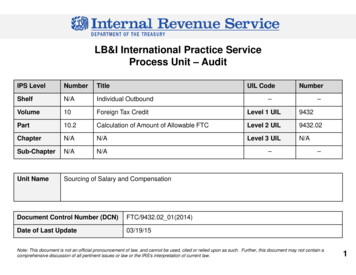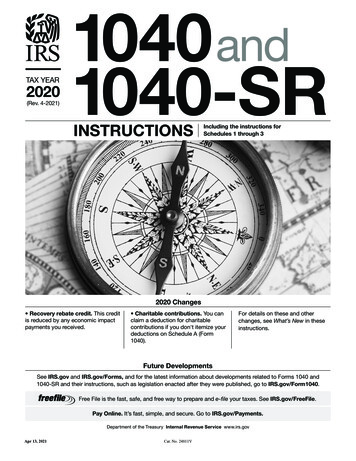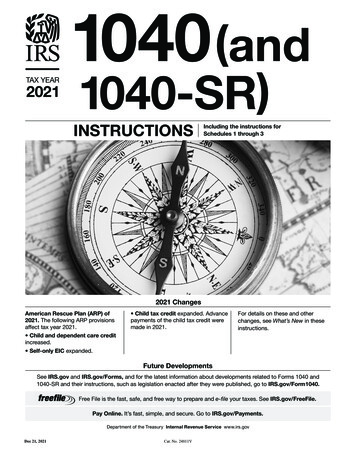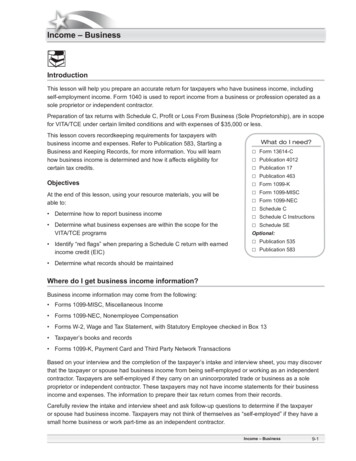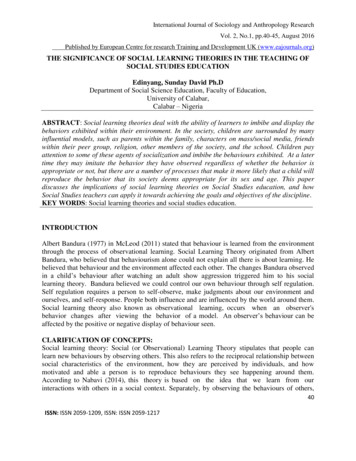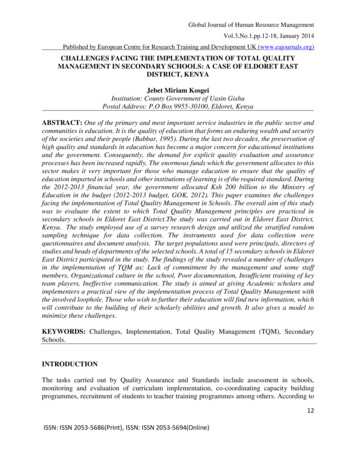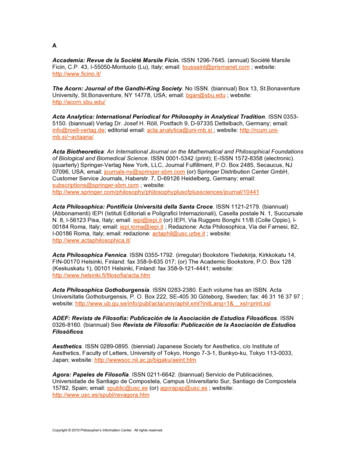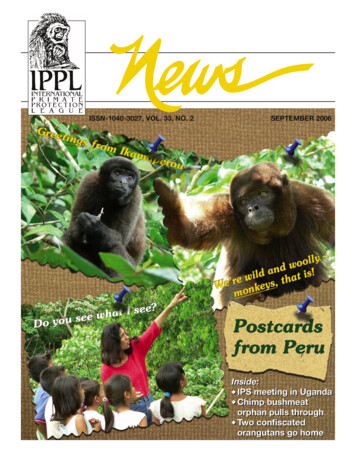
Transcription
ISSN-1040-3027, VOL. 33, NO. 2SEPTEMBER 2006Inside: IPS meeting in Uganda Chimp bushmeatorphan pulls through Two confiscatedorangutans go home
A Letter from IPPL’s Chairwoman Shirley McGrealDear IPPL Member,In a rescue center run by the Wildlife Friends of Thailand, there is a special island measuring 2,000 squaremeters. It is IPPL’s island, established by Edwin Wiek for sanctuary gibbons rescued from abusive situations.IPPL made a construction grant in March 2005, but weather caused delays as the lake surrounding the islanddried up. Any released gibbons could easily have jumped out!Edwin reports,We were able in March 2005 to dig up the island, as thewater levels were very low and the rainy season was stillfar away. The digging was done by a large excavator andtrees were planted a few weeks after. The drought howevercontinued. To make the trees survive, we needed to waterthem for months. The water level in the lake got lowerand lower. We were afraid the gibbons could not move onto their new island any time soon! The trees were gettinglarger and greener by October, but the rain didn’t come.Kookoo playing on the island.By the fall of2005, constructionThe IPPL-sponsored gibbon island createdof the new islandby Wildlife Friends of Thailand.enclosure wascompleted.Swinging ropes and other enrichment items were added. Everyoneprayed for rain.Fortunately the long-awaited rainy season began in October 2005.Edwin commented that it rained non-stop for days and that within twoweeks the lake was full. The island was lush and green, and finallyready to be occupied by gibbons.Six young gibbons were released. They have adjusted well and arenow swinging happily round their new home, greeting each new daywith gibbon calls.This happy ending is just one of the many successes of IPPL’s smallgrant program. Edwin sends his thanks to IPPL supporters for their help.eeefffHere at IPPL Headquarters in South Carolina, we have been experiencing a heat wave. Temperatures havebeen close to the 90s every day for several weeks. I don’t know how the gibbons manage but, as I look outsidemy window from my work-desk, I see Elsa and Nicholas wrestling and Brownie swinging the length of hisenclosure. Gibbons have thick coats, which provide some insulation. However, they often go indoors in themiddle of the day.We have had a bounteous peach season and the figs, blueberries and grapes grown on our land have beendelicious. The gibbons have fun watching us picking them! With produce prices sky-high these days, the morewe can grow here at home, the better. Our home-grown produce is also enjoyed by our resident squirrels ——————————IPPL ———September 2006
International Primatological Society Meets in UgandaShirley McGreal, Chairwoman, IPPLThis past June, accompanied by LindaHoward of Allied Effort to Save OtherPrimates (AESOP), I attended the 21stCongress of the International PrimatologicalSociety (IPS). The conference was held inUganda from 25-30 June 2006 in Entebbe.Around 750 people were present, themajority of whom were primate fieldworkers, many of them from Africannations. IPS conferences are held everytwo years and alternate between habitatcountries (those with native primates) andnon-habitat countries (those unfortunateenough to have no nonhuman primates).The theme of the 2006 conferencewas “African Conservation in Action.”William Oluput of Uganda served asCongress chair. President Museveni ofUganda and Ugandan wildlife officialswere among the speakers at the officialopening ceremony.The program was intensive, with dailyplenary sessions and several concurrentsessions, usually six at a time. The book ofabstracts weighs two pounds, nine ounces!Selecting which session to attend was oftena challenge. The plenary speakers includedtwo of Uganda’s top primatologists, Dr.Gilbert Isabirye-Basuta and Dr. JerryLwanga of Makerere University, whorun programs at Kibale National Forest.Both expressed concern over the rapidrate of habitat destruction, because it is“occurring so fast that primates may nothave time to adapt.”Jane GoodallDr. Goodall gave a brief history ofchimpanzee studies at Gombe where shebegan her research over 40 years ago. Shecommented on the situation at Gombe andother primate study sites, noting that,More and more study sites will come toresemble Gombe—islands of habitat in asea of human-altered landscape.Throughout the congress Janeseemed tireless: she held a fund-raiser,attended several conservation-orientedsessions, gave a presentation to Ugandanschoolchildren on the lawn in front of theconference hotel, and patiently signedautographs.Human diseases imperil gorillasOne session included several alarmingpresentations regarding transmission ofhuman diseases to endangered gorillas.Some unhabituated gorillas have the goodfortune to live in areas of very low humandensity, but others live in small areassurrounded by dense human populations.Hence, wildlife veterinarians specializingin ape health problems need to be familiarwith health problems affecting humansand livestock. Such diseases can betransmitted to gorillas.Dr. Gladys Kalema-Zikusoka of theUgandan group Conservation ThroughPublic Health (CTPH) discussed a scabiesoutbreak in the Bwindi ImpenetrableNational Park mountain gorillas. Theoutbreak was traced to the local community.CTPH’s programs include treatment oftuberculosis and other diseases in humansand public health education, in addition towild animal care.Veterinarian Mike Cranfield, whois associated with the Rwanda-basedMountain Gorilla Veterinary Project(MGVP), discussed employee healthprograms established for the staff ofall projects working with gorillas. Inaddition, MGVP provides care to sick orinjured gorillas. It emphasizes preventionof sickness in gorillas, who can beinfected by many human diseases. This isaccomplished by caring for the local humanpopulation. Through its Employee HealthProgram, all personnel who participatein any program involving human contactwith mountain gorillas receive thoroughand regular health screenings.Gorilla tourismChris Sandbrook of the ZoologicalSociety of London reported on hisobservations of gorilla tourism in theBwindi Impenetrable National Park,Uganda, and expressed concern that touristswho trek mountain gorillas in Uganda couldinfect them with diseases. Sandbrook andhis colleagues took measures of how closetourists got to gorillas and found that amajority got closer than the rules allow(the rules require a five meter �——————————IPPL NEWSwww.ippl.org3They noted that it was not solely the faultof the guides and the tourists, as the gorillasinitiated the closest and longest contacts.They recommended that guides be trainedin stricter enforcement of rules, that touristsbe health-screened, and that surgical masksbe worn in the presence of gorillas.Mangabey sessionOn 27 June a session was held on “TheMangabeys of Africa.” During this sessionDr. James Else of the Yerkes PrimateCenter, Atlanta, Georgia, USA, presented apaper on the subject of how “A biomedicalconservation partnership helps to securethe future of the sooty mangabey.” Elsediscussed the Yerkes Primate Center’smangabey colony. However, he omittedany mention of Yerkes’ pending applicationto perform lethal disease research onsome of these mangabeys and to kill offsuperannuated (elderly) animals. I raisedboth these questions during the Questionand Answer period after the talk. Dr. Elsedid not provide a satisfactory answer.David WattsDavid Watts, who used to studymountain gorillas in the Virunga Volcanoeswith the late Dian Fossey, gave a thoughtprovoking presentation on “The Roleof Television Documentaries in GreatApe Conservation.” Film producers haveshown a strong interest in chimpanzees andmountain gorillas. This has grown as morefree-living ape groups have been locatedand habituated. Watts pointed out thepositive side: viewers may be sensitized toconservation issues by learning about thesignificance of apes and the seriousnessof their current predicament. But Wattsis also concerned that much of the filmmakers’ interest is focused on negativeaspects of chimpanzee behavior, such aschimpanzee “murderousness” and intergroup aggression, and that this couldbackfire with the Western public. It couldalso disturb the public and decisionmakers in habitat countries.One example of such a film was theNational Geographic Society’s specialcalled “The Dark Side of Chimpanzees.”This program showed —September 2006
tracking down and brutally killing anotherchimpanzee, and it contained many otherdisturbing scenes.Uganda Wildlife Education CenterThe former Entebbe Zoo, now knownas the Uganda Wildlife Education Center(UWEC), houses chimpanzees (all rescuedfrom trade), patas monkeys, and olivebaboons, as well as other birds andmammals. Vervet monkeys wander free onalso special features on Uganda’s greatapes: mountain gorillas and chimpanzees.The exposition will be taken aroundUganda and to other nations.Post-conference activitiesFollowing the conference, manyparticipants took the opportunity toexplore Uganda. Uganda’s wildlifewas decimated under former PresidentIdi Amin, but has started to recoverin recent years. Gorilla trekking inthe Bwindi Impenetrable NationalPark was an attraction for some ofa large troop of patas monkeys, whoare known for their high-speed longdistance running. On the boat ridealong the Nile River we saw hundredsof hippos, crocodiles, and several herdsof elephants. The falls themselves werespectacular.From Murchison Falls we drove overmainly dirt roads to Queen ElizabethPark. We stayed two nights at JacanaLodge in the forested section of thepark and saw large numbers of beautifulblack-and-white colobus monkeys. Thelively troops included many babies; weA snoozing warthog carefully groomed by banded mongooses.UWEC’s Mukasa Yekoyada & methe grounds. The facilities are spacious. Wewere shown around by animal caregiverMukasa Yekoyada, who told us the historyof many of the center’s residents.Both Linda and I felt that the conditionsat UWEC were far superior to those inmany Western zoos. There was a spaciousquarantine area for incoming baboons, aswell as a large attached outdoor enclosurefor them once they were released fromquarantine.GRASP exhibitionOn 28 June the Great Apes SurvivalProject (GRASP), which is part of theUnited Nations Environment Program, heldthe formal opening of its international apeexposition at Uganda’s National Museumin Kampala. Posters and exhibits explainedthe plight of apes worldwide. There werethe hardier delegates. Many otherswent chimp-trekking in the KibaleNational Park and Budongo ForestReserve. Others observed wildlifeat the Murchison Falls and QueenElizabeth National Parks.Linda and I wentfirst to Murchison FallsNational Park. The longdrive to Murchisonwas made moreinteresting by us seeingmany baboon troopsand schoolchildrendressed in coloreduniforms; each schoolhad different brightcolors.We c r o s s e d t h eNile by ferry. In theA vervet checks out our Land Rover! national park we �———————IPPL NEWSwww.ippl.org4watched them for hours. We also sawred-tailed guenons.The next stop was the Mweya Lodgeon the shores of Lake Edward, with aview of the Ruwenzori Mountains. Oneof our most memorable animal thrillstook place at Mweya and did not involveprimates! Right in front of our room atthe lodge, we saw a mother and juvenilewarthog. They were in deep sleep. About20 mongooses were grooming them—theywere crawling all over the sleepingwarthogs! Warthogs have sharp tusks andare capable of aggressive behavior, but onthis occasion they seemed to be enjoyingall the attention and dozed on!Uganda seems to be recovering fromits dark days. We found the people to beuniformly friendly. The conference wasextremely well organized and a totallyworthwhile —September 2006
U.S. Zoos’ Monkey DealIn May 2006, six U.S. zoos, led by SanDiego Zoo, imported a group of 33 monkeysfrom South Africa. The monkeys belongedto five species not native to South Africa:eight Schmidt’s spot-nosed guenons (seephoto below), six Allen’s swamp monkeys,eight black mangabeys, six De Brazza’smonkeys, and five Wolf’s monkeys.According to the 8 May 2006 issue ofthe Los Angeles Times, the zoos had paida South African animal dealer namedMike Bester 400,000 for the monkeys.Bester reportedly procured the animalsfrom a South African businessman,not identified in the article, who hadpurchased them from markets in theDemocratic Republic of Congo (DRC).All the monkeys belonged to specieslisted on Appendix II of the Conventionon International Trade in EndangeredSpecies (CITES).According to the text of CITES, exportshould only be allowed when:1) a Scientific Authority of the State ofexport has advised that such export willnot be detrimental to the survival of thatspecies; and2) a Management Authority of the Stateof export is satisfied that the specimen wasnot obtained in contravention of the lawsof that State for the protection of faunaand flora.IPPL filed a Freedom of InformationAct (FOIA) request with the U.S. Fishand Wildlife Service for documentspertaining to the shipment and also soughtinformation from DRC authorities.Among the documents provided by theU.S. Fish and Wildlife Service were:1) A CITES re-export permit from SouthAfrica issued on 21 February 2006 toBester’s Birds and Animals for 34 monkeys(one of the De Brazza’s monkeys was notshipped for health reasons). The animalswere correctly listed as II-W, which meansCITES Appendix II, wild-caught.2) A Form 3-177 U.S. importdeclaration. This included a list of the33 animals, who were shipped on KLMAirlines and imported via San Francisco.The II-W designation on the SouthAfrican export documents was not there.The animals were listed as LIV-C (Cstands for captive-born). The percentageof “wildlife inspected” was blackedout, although none of the exemptionsto the Freedom of Information Actshould include information regarding theperformance or non-performance of theirduties by inspectors. An appeal of thisdenial has been filed.3) A document showing that theanimals would be delivered by the animalground shipping company Kritter Kratesto a firm called Valley Biosystems in WestSacramento, California, for quarantine.The Valley Biosystems company was anexhibitor at the Society of Toxicology’sconference in 2006 and has strong researchinterests. Why San Diego Zoo would usea research facility as its quarantine stationis not clear.A Schmidt’s spot-nosed guenon,one of five species wild-caught inthe DRC and exported via SouthAfrica to several U.S. zoos.Photo Allen —————————IPPL ———September 2006
IPPL contacted Ms. Karen Killmar,the Associate Curator of Mammals atthe San Diego Zoo, on 12 July 2006,commenting,Ms. Killmar, we learned that theSacramento quarantine station you usedfor your monkey transaction only registeredas a primate importer in January 2006 Idon’t know if you have read CITES rulesre Appendix II shipments. They do requirea no-detriment finding from the ScientificAuthority of the country of export and afinding by the Scientific Authority of thestate of re-export (South Africa) that allwas in order with the original export.Please provide IPPL with a copy of theDRC export permits. These were notattached to the Form 3-177. Further, the3-177 obtained under FOIA states thatthe monkeys were II-C when they wereII-W, assuming they were rescued by the“secret” middleman. You may wish torequest to USFWS/LE [Law Enforcement]to amend the form.Extensive discussions by myself andothers with employees of the DRC ScientificAuthority (ICCN) show that they were notconsulted in regard to the “no-detriment”finding—which would be impossible tomake in the absence of current census dataon each species.Unfortunately, no reply has beenreceived.The export documents from the DRCwere not among the documents receivedby IPPL. However, IPPL has been intouch with several officials of the DRC’sScientific Authority, without whoseapproval export of the monkeys shouldnot have been permitted. Not one wasthem was aware of the shipment. PasteurCosmos Wilungula Balongelwa, DirectorGeneral of the Institut Congolais pourla Conservation de la Nature (ICCN),has denounced this commerce in hiscountry’s wildlife. In addition, tworepresentatives of ICCN attended theInternational Primatological SocietyCongress recently held in Entebbe,Uganda. Their names were Gaby Kitengieand Nono Bondjengo. Shirley McGreal ofIPPL and Linda Howard of Allied Effortto Save Other Primates showed them theFOIA documents, with Shirley translatingeach one into French, and they were verysurprised, saying they had not knownabout the shipment. They requested IPPLsupport in their efforts to stop furtherexports of DRC monkeys.Wildlife officials from the Democratic Republic of Congo, Gaby Kitengie(left) and Nono Bondjengo (right), meet with Shirley McGreal at theInternational Primatological Society conference in Uganda to discuss ashipment of wild-caught monkeys from the DRC that had been boughtby U.S. zoos.Mangabey Permit ControversyThe U.S. Fish and Wildlife ServiceManagement Authority is consideringa permit application filed on 18 May2006 by the Yerkes Primate Center (PRT837068), Atlanta, Georgia, USA. Yerkesis asking to be allowed to kill sootymangabeys by infliction of lethal diseasesand killing “superannuated” (elderly)animals. Permits are required for suchactivities because mangabeys are listedon the U.S. Endangered Species List. Inreturn, Yerkes offered to pay 30,000 ayear for five years to a mangabey fieldproject in the Taï National Park in theAfrican nation Côte d’Ivoire (IvoryCoast).Under U.S. law, endangered speciespermit applications are opened for a 30-daypublic comment period. Letters opposingthe application have been submittedby many animal protection groups andconcerned individuals. Among thosesubmitting comments was a coalitionformed of nine organizations: the AmericanAnti-Vivisection Society, the Animal LegalDefense Fund, the Animal ProtectionInstitute, the Animal Welfare Institute,In Defense of Animals, the InternationalPrimate Protection League, the NewEngland Anti-Vivisection Society, Peoplefor the Ethical Treatment of Animals, andthe Physicians’ Committee for ResponsibleMedicine. A final decision had not yet beenmade as of 16 August 2006.On 29 July 2006, Christophe Boesch,who has been studying the ——————————IPPL NEWSwww.ippl.org6of the Taï Forest for over three decades,submitted belated comments to theManagement Authority. The officialdeadline was 19 June 2006. However,many field primatologists spend muchof their time in the forest and are late inkeeping up with the news! Extracts fromDr. Boesch’s comments follow.I have only recently been informed aboutthe Yerkes application P-837068 to requestan exemption from the ESA [EndangeredSpecies Act] in relation of mangabey SIVresearch. Especially this is connected witha field project on mangabey in the TaiNational Park in Côte d’Ivoire. Workingmyself for years in this NP, I would liketo make some comments on the value mber 2006
legitimacy of that application.HIV is notSIV. Over 25 species of monkeys and apeshave different SIV viruses, all of which aredifferent from one another and sometimesquite divergent. None of those monkeys areknown to suffer from being carrier of thevirus. Therefore, they cannot profit fromwork on SIV. Second, the hugely importantquestions of how SIVmang [mangabeysimian virus] becomes a virulent HIV canbe done without killing the host.The precedent of “paying to killendangered species animals” has farreaching consequences that would bringthe USA conservation policy in conflictwith all the international efforts to protectthe biodiversity of this planet.The Tai monkey project is a veryimportant and valuable research projectthat needs funding. If the USFWS orYerkes feels that way, they should beencouraged to support this project basedon its intrinsic value. That should be nojustification whatsoever to kill endangeredanimals.A group of scientists including Dr. JaneGoodall also signed a letter opposing theplans to kill mangabeys. The letter came tothe attention of the New York Times, whichinterviewed Jane. The following exchangetook place and was reported in the 16 July2006 issue of the newspaper:Interviewer: I hear you just signeda letter to the U.S. Fish and WildlifeService requesting that it reject a proposalto do AIDS research involving the sootymangabey monkey.Jane: The answer to the AIDS epidemicis not lying in research with monkeys.Interviewer: We cannot know until wetry, and don’t you think we are morallyobligated to try everything we can?Jane: Yes, I do, but I think we havewasted huge numbers of dollars doingthings with chimps and monkeys. Mostmedical breakthroughs are not the resultof work with animals, although the lawrequires the new breakthrough to betested on animals before it can be appliedto people.As noted on page 3, Dr. James Elseof the Yerkes Primate Center made apresentation to a mangabey symposiumheld at the International PrimatologicalSociety Congress in June 2006, which didnot include any information about Yerkes’plans to kill mangabeys.Protest the Killing of Yerkes’ MangabeysIf you haven’t yet submitted comments on this application, please contact the Fish and Wildlife Service,regardless of the deadline having passed. Request that the permit PRT-837068 not be granted to the YerkesPrimate Center, allowing them to kill their sooty mangabeys in exchange for sponsoring primate fieldwork.Point out that granting this permit would set a very dangerous precedent, allowing any future organization to“buy” the right to kill endangered animals. Please include the permit number and send your comments to:Timothy Van Norman, Chief, International PermitsU.S. Fish and Wildlife Service, Division of Management AuthorityArlington Square Building4401 North Fairfax Drive, Room 700Arlington VA 22203, USAFax: 703-358-2281Nepal Monkey Lab Plans Raise ProtestsThe rhesus macaque is found in severalAsian countries, including India, China,and the small land-locked nation ofNepal, where many of the highestmountains of the world are located,including Mount Everest. In the past,the remoteness of the country, Nepal’sstrong religious traditions, and therugged terrain resulted in protectionfor its native monkeys. Now that seemsabout to change, and many Nepalese areunhappy. Foreign scientists are showingan interest in conducting research onNepal’s rhesus macaques.In 2003, 39 monkeys living at theSwoyambhu Temple, an ancient Buddhistsite, were trapped and examined bystaff of the Washington Regional (nowNational) Primate Center, Seattle,Washington, USA. Blood was taken tothe United States for examination. Anarticle resulting from the research canbe found online tm).At the present time, two Nepaleserhesus monkey breeding and exportingfacilities funded by United States-basedorganizations are under construction, one bythe Washington Primate Center and one bythe Southwest Foundation for BiomedicalResearch. Nepalese animal protectiongroups oppose both projects. According toa joint press release issued in July 2006 byAnimal Nepal and Wildlife Watch �————————IPPL NEWSwww.ippl.org7Close to 1200 people from 21 nationshave signed a petition calling on Nepal tocancel its plans to establish laboratoriesusing rhesus monkeys and to exportmonkeys.Signers came from a variety of nations:India, Nepal, Singapore, Ireland, Belgium,the Netherlands, Australia, Canada, theUnited States, Hong Kong, the UnitedKingdom, China, New Zealand, Panama,Jordan, UAE, Israel, Colombia, Spain,and Japan.Animal Nepal and Wildlife Watch Grouphave joined hands with the world’s leadinganimal welfare agencies and biologiststo oppose the breeding and exporting ofNepalese monkeys for biomedical September 2006
in America. The monkeys are to go toWashington and Texas where potentiallydangerous and/or lethal experiments willbe carried out on them.Tw o A m e r i c a n a g e n c i e s , t h eWashington National Primate Center(WNPC) and Southwest Foundationfor Biomedical Research (SFBM), andtheir Nepalese counterparts receivedgovernment permission to catch, breedand export Nepalese rhesus monkeys forthis purpose.The campaigners in theirpetition outline that monkeys areconsidered sacred and are animportant part of Nepal’s heritagefor a number of reasons. They sayNepal will not deserve credit forproviding monkeys for biomedicalresearch by maintaining outdated,unreliable, and unethical methodsfor conducting studies. Mostcountries now maintain a completeban on great ape experimentation.India, for instance, after realizingthat its monkeys were used forgruesome radiation experiments inthe US, banned all primate exportsin 1977.American centers try to findloopholes in the world’s legalanimal rights provisions, and inNepal (one of the few countriesin the world still largely withoutsuch legislation) it has found idealworking ground.The campaigners stronglyrequest the Nepalese governmentto demonstrate its commitment toenlightened and ethical researchpractices by halting breeding facilities forbiomedical research on Nepalese monkeysand implement legislation to prevent suchdevelopments from reoccurring.The petition can be found on theInternet , and AnimalNepal can be visited online (http://www.animalnepal.org/).Southwest Foundation projectIPPL recently contacted the SouthwestFoundation for Biomedical Research. Thecenter’s director, Dr. John L VandeBerg,confirmed that Southwest is indeedsponsoring a rhesus monkey breedingcenter:The project that I am establishing inNepal is being funded by NIH. The goal ofthe project is to develop a breeding colonyof rhesus monkeys in order to produceprogeny for exportation to the U.S. Thesemonkeys will help fill the critical shortageof rhesus macaques for biomedicalresearch, a shortage that has caused alocales, determined by the governmentas being areas where monkeys areoverpopulated and where their largenumbers cause problems for humanhabitations or agricultural enterprises.The location where each monkey iscollected is recorded and reported toNepali government authorities. The Nepalistaff have purchased or are about topurchase a GPS for identifying the exactlocation of each monkey’s acquisition.IPPL has learned that in 2004Dr. VandeBerg received a grantof 684,040 from the Division ofResearch Resources, a divisionof the U.S. National Institutesof Health (NIH). The grant wasnumbered 5P40RR018825-02 andentitled “Rhesus Breeding ColonyIn Nepal And Importation To USA.”The grant covers the years 20042009. The project abstract states:There is a severe shortageof rhesus monkeys required tofulfill critical needs in research onAIDS, on development of vaccinesagainst infectious agents that couldbe used as biological weapons,and on a wide variety of othertopics in biomedical research.Rhesus macaques derived frommonkeys of Indian origin haveunique characteristics that areparticularly valuable in research onthe development of AIDS vaccines.Despite the recent expansion ofA rhesus macaque at thebreeding colonies in the UnitedSwoyambhu Temple, Nepal.States, the shortage of theseimportantresearch animals is actuallytwo- to three-year delay in some researchprojects and holds up the development of increasing in severity, accentuating thepotential new vaccines and treatments for need for new sources of Indian-typelife-threatening diseases, including AIDS rhesus. Indian-type rhesus macaquesand tuberculosis which are major killers in exist in large numbers throughout manyregions of Nepal. There are no restrictionsNepal and in many other countries.In addition, this breeding colony will be against export of these animals froma potential source of monkeys that could Nepal. The objective of this proposal is tobe used to repopulate areas of Nepal in address the urgent need for a new sourcewhich rhesus monkeys might become of Indian-type rhesus macaques for usein biomedical research by developing athreatened in future decades.All monkeys being used to stock the captive breeding colony in Nepal. Wefacility are obtained in Nepal under permit aim to develop a self-sustaining colonyand oversight of Nepali government capable of supplying 75 animals per yearofficials. A specified number of monkeys to the US to meet critical biomedicalmay be collected from each of several research �————————IPPL ———September 2006
Washington National PrimateCenter projectAccording to a Washington PrimateCenter statement dated 31 May 2006,Scientists investigating the geneticmakeup of rhesus macaque monkeys, a keyspecies used in biomedical research, havefound the rhesus in Nepal may provide asuitable alternative to alleviate a criticalshortage of laboratory animals used inwork to develop vaccines against diseasessuch as HIV/AIDS.this is importantbecause Indian-origin animals havebeen used for more than half a centuryin biomedical and behavioral research.Rhesus macaques have contributed tothe discovery of vaccines to preventdiseases such as polio and yellow fever,and represent one of the most widely usedprimate models for AIDS-related research.India, however, banned the export of allmacaques in 1978, thus leading to thecurrent shortage.Although China has been exportingcaptive-bred animals for some time,scientists have noted a number ofbehavioral and physiological differencesin disease progression between animalsfrom the two countries, and the Indianorigin macaques are generally preferredin research on certain diseases.The new study was spearheaded byKyes, a primatologist and head of the UW’sDivision of International Programs at theWashington National Primate ResearchCenter, in collaboration
at UWEC were far superior to those in many Western zoos. There was a spacious quarantine area for incoming baboons, as well as a large attached outdoor enclosure for them once they were released from quarantine. GRASP exhibition On 28 June the Great Apes Survival Project (GRASP), which is part of the United Nations Environment Program, held
